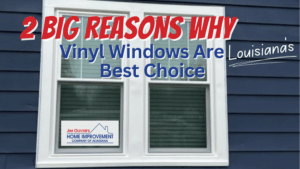Have a pressure washer? With pressure washers becoming standard equipment for DIYers worldwide, chances are you do. However, you may not know these 7 common pressure washing mistakes that sabotage your home improvement efforts. We got your back…
Pressure washers are extremely useful, especially down here in Louisiana, where the humidity allows mold, moss, and more to grow quickly. Even if it’s just spring cleaning, most home exteriors in Acadiana need pressure washing every year or two. And with $3 billion global sales expected by 2024, pressure washers are popular, but most don’t consider the potential problems.
Consumer-grade pressure washers are easy to use, but they also require caution to avoid injury or accidental property damage. Make your life simpler and safer by avoiding these seven common mistakes committed by pressure washer newbies.
7 Pressure Washing Mistakes
-
Forgetting to Angle the Spray
When pressure washing, spraying at an angle —and not straight on —is important. When you spray dirty surfaces directly, the dirt is driven deeper into whatever surface (especially porous surfaces like wood and concrete).
The goal is to get under the dirt to spray it away. Tough or embedded stains may require moving around and attacking from different directions, but an angle is vital.
Besides not removing the dirt or stain, not spraying at an angle may cause blowback dirt. How would you like that junk in your face, or specifically in your eye? That leads us to mistake #2…
2. Not Using Safety Equipment
Pressure washers may look fun, like an adult Super Soaker, but they are not toys. Believe it or not, a narrow stream of water discharged at several thousand pounds per square inch (PSI) can slice through flesh like a saw. Even worse, the high pressure drives water and dirt deep into the tissue, often leading to infection.
So, be alert. Wear close-toed shoes, in case you drift off into a daydream and forget you have a high-powered water cannon in your hands. Your piggies deserve protection. AND PLEASE, don’t for get the safety glasses.
3. Using the Wrong Nozzle
There are specific nozzles for specific jobs. Pay attention. Selecting the right pressure washer nozzle tip is a key for both safety and efficiency. Generally, you can pressure wash almost anything as long as you’re using the right nozzle! Nozzles change the angle and spread of the spray, affecting the PSI coming out of the wand. For instance: A wider angle creates a lower pressure.
Follow your manufacturer’s suggestions and if you have any concerns, consider test spraying a small, less visible area that’s more easily fixed.
This ABC News story reveals the risks associated with pressure washers, with a special focus on the increased danger posed by using zero-degree nozzles.
4. Spraying Upward Against Siding
At Jim Olivier’s Home Improvement, we want you to love your home. But as previously mentioned, Louisiana’s humidity requires regularly pressure washing your vinyl siding.
When you do, never direct the spray up into the siding. Siding channels water down from the roof to the foundation. Properly installed, siding is intentionally left open on the bottom so that any water harmlessly drains out. Spraying from below will force water in between the siding and the house. Unless you want a mold problem, you don’t want moisture in there.
Some of you may be thinking, “Ok… I’ll just hop on a ladder.” DON’T DO IT. The kickback may be strong enough to make you lose your balance.
Your best bet is to stay on the ground and use a telescoping extension wand. Look for an attachment with a pronounced downward angle or slight curve. This allows you to spray from top to bottom or along the face of the siding, without adding an ER trip to the list of potential pressure washer problems.
5. Pressure Washing Asphalt Shingles
This is more for our Roofing Louisiana customers, but it’s important to touch on here. DON’T PRESSURE WASH your asphalt shingles. Why? A. As water is designed to flow from the top down, spraying underneath your shingles will force water into space you don’t want (and will cause greater problems later). B. Pressure washing will damage the shingles by blasting off their protective coating causing their life-span to lessen and… C. It will void the manufacturer’s warranties.
If you see growth on your shingles, consider a local soft-washing service. If you notice wavy patterns or other damage, reach out to our pros at Roofing Louisiana and get a free quote for an expert roof replacement.
6. Pressure Overload
Pressure washer pumps generate a closed system of pressurized water. When you pull the trigger on the spray gun, that pressure is released. But what happens when you’re not pulling that trigger?
The pressure can’t be allowed to build up in one spot, so a bypass valve re-directs water away from the spray gun and back into the system. It’s a solution that comes with one downside: temperature. All that re-directed water is continuously heated as it circulates through the system. Eventually, it gets hot enough to damage the pump, leading to early burn-out and a costly repair. (Some models avoid this issue by using ceramic-lined parts, but those generally aren’t in the consumer-grade price range.)
Don’t turn on the pressure washer unless you’re ready to use it. To be safe, if you need to take care of something else, turn off the washer until you’re ready to start work again. Most models are ok with short minute-long breaks, but we prefer you be safe than sorry.
7.Using a Gas-Powered Pressure Washer Indoors
Gas-powered pressure washers are more powerful and portable than corded electric models, making them a favorite for professionals and DIYers. HOWEVER, they also produce carbon monoxide, and should never be used without proper ventilation.
Though the majority of your pressure washing jobs are outside and few Louisiana homes have basements, this is worth noting. If you need to pressure wash a shed floor, make sure you have proper ventilation.
Hope this helps your avoid these common pressure washing mistakes. If you have any question, feel free to reach out to experts at Jim Olivier’s.




